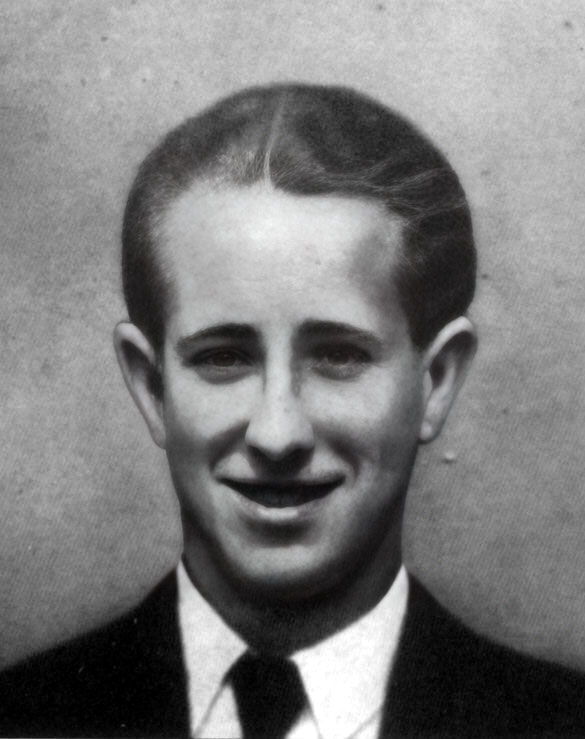
Blood Martyrs of the National Socialist Movement
The Year 1933
Walter Wagnitz
(23 July 1916, 1 January 1933)

Walter Wagnitz (23 July 1916, 1 January 1933) was a resistance fighter against the Weimar Republic and a Blood martyr of the National Socialist movement.
Walter Wagnitz was standing in front of the door of a pub on Utrecht Street in Wedding. A cheerful noise was coming from inside, the „Schar 3“ of the Hitler Youth was celebrating New Year’s Eve. An hour ago he clinked glasses with his comrades. „To a happy new year!“
The 16-year-old Hitler boy and tailor’s apprentice Walter Wagnitz is killed by a dagger thrust to the abdomen in Wedding, Utrechterstraße. The perpetrator is said to have been a communist named Sarow.
An acquaintance of Walter Wagnitz told about his parents:
They had only adopted the boy. He was their foster son. They lived in a one-room flat, a tenement in Liebenwalder Straße, in Wedding. Rutkowski was the parents’ name. The old man was a worker. Yes, what more should I tell you about Walter Wagnitz. He had joined the National Socialist Students’ Association at an early age. He had kept this secret from his parents. It was the first time he hadn’t told them something. But when he joined the Hitler Youth, he did talk about it. - An unknown working-class boy. That was Walter Wagnitz. Now, through his death, he has become our champion. He sacrificed his life for us. We are all now in his debt. Only by intensifying our efforts can we pay it off. We continue the struggle. - That was our oath! And we have won! Walter Wagnitz, you died for the new, great Germany. It will be eternal. F.W.
Utrecht Street in Berlin-Wedding was renamed Walter-Wagnitz-Strasse. A commemorative plaque was placed at the site of the murder, house number 24:
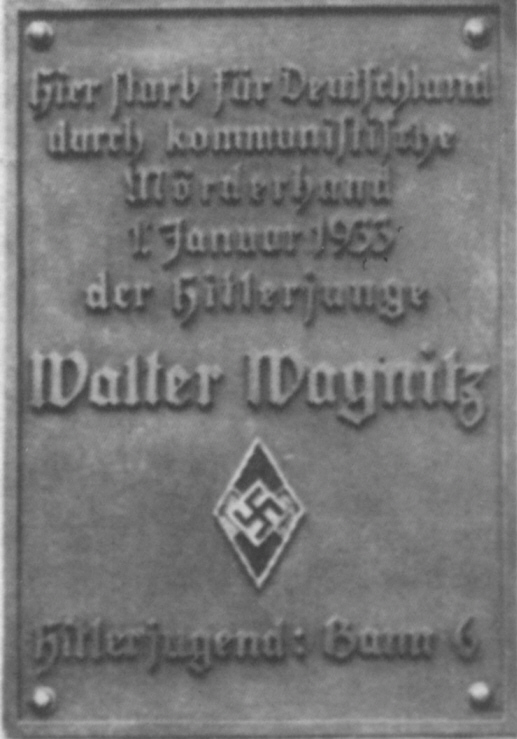
Here died for Germany
by communist
Murderer’s Hand
1 January 1933
the Hitler Youth
Walter Wagnitz
The Berlin Gauleiter Joseph Goebbels wrote in his diary that 100,000 people had paid their last respects to the Hitler Youth at his funeral.
His name was added to the list of the Immortal Allegiance of the Hitler Youth.
The newspaper Der Angriff wrote about the events:
Berlin honours the dead Walter Wagnitz.
Impressive funeral service for the murdered Hitler Youth, 100,000 in the Lustgarten.
The Hitler youth Walter Wagnitz, murdered by communists on New Year’s Eve, was laid to rest on Saturday with the greatest sympathy from the German population of Berlin. At 1.30 a.m. a short funeral service took place in the mortuary of the morgue, attended not only by the parents of the deceased but also by Dr. Goebbels, Dr. Meinshausen and the Reich Youth Leader Baldur v. Schirach. The wake was kept by the comrades of the murdered man from the Hitler Youth Schar 3. In the surrounding streets the entire SA. SS and Hitler Youth had lined up in the surrounding streets and then joined the funeral procession. The flags of the Berlin Movement were carried at the head, followed by the hearse and parents of the dead boy. Then marched the Pgg. Dr. Goebbels, von Schirach, Prince August Wilhelm of Prussia and Stabsführer von Arnim.
Tens of thousands of people had lined up in the streets to let the funeral procession pass and then join it. The march through the city to the Luisenstadt cemetery lasted over two hours. The area around the cemetery had been cordoned off by the police. Here too, tens of thousands stood packed in the surrounding streets to pay their last respects to Walter Wagnitz. Pastor Loerzer gave the eulogy, then Dr. Goebbels, Baldur von Schirach and the HJ-Bannführer Jahn spoke. The first verse of the Horst Wessel song sounded, the flags were lowered, and a mountain of wreaths and flowers was laid on the grave. Then the masses formed up again and moved to the Lustgarten, where a hundred thousand people had gathered at around 7.30 am. From the castle ramp, Oberführer Ernst spoke first, then Baldur v. Schirach, and finally Dr. Goebbels took the floor for a blazing accusatory speech against the murderers, and against the system that cannot prevent such crimes.
„We lift up our hearts and hands and cry, „This far and no further“. Our patience is at an end. The Jews are to blame, is our charge. They have desecrated our honour. They take our work and bread, they incite civil war. They do not want to let Germany rest, and now that they realise that a front of twelve million is marching towards them, now they begin to tremble, now the fear neurosis of the parasite is in their limbs. They know that Adolf Hitler is at the door. They talk of division, decomposition and mutiny. With them, the wish is the father of the thought. They know that we stick together, and if we were to split, then Juda would take over.“
Hundreds of thousands then sang the Horst Wessel song and moved towards their homes in the evening in peace and discipline.

Erich Sagasser
(* 9 December 1909, † 8 January 1933 in Berlin)
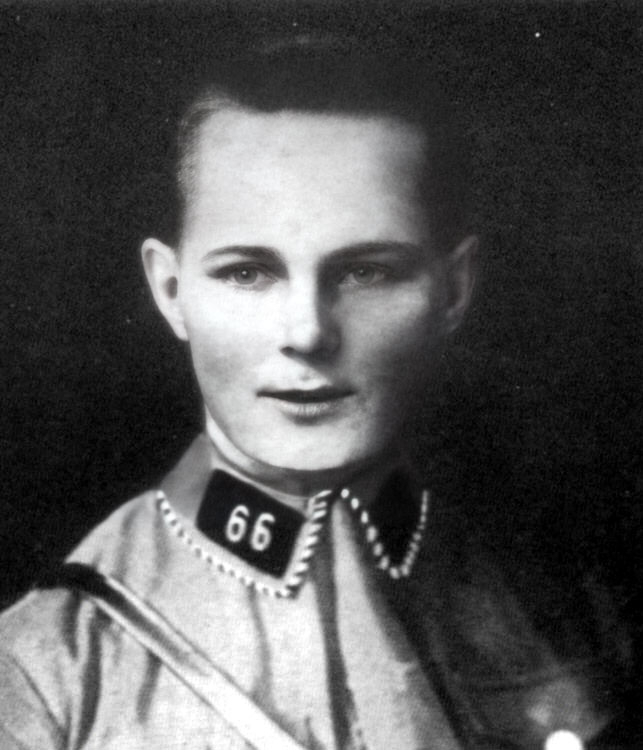
Erich Sagasser was a resistance fighter against the Weimar Republic and a Blood martyr of the National Socialist movement.
Erich Sagasser was walking home with two comrades after a Christmas party on the night before Christmas Eve 1932. In the process, he was seriously injured by communist stab wounds in red Moabit. He succumbed to his wounds on 8 January 1933. The father of the fallen man joined the SA himself after his son’s death. He became a flag bearer of Sturm 66/12, in which his son had served.

Honorary march for Erich Sagasser
The newspaper Der Angriff wrote about the events:
We lower the flags at the open crypt:
„Report to Sturmbann Horst Wessel, Erich Sagasser!“
A worker fell for Germany - a nation mourns him.
Again, drums roar through Berlin. Again the black hearse sways. Again brown columns march, again the flags wave ... The sound of the drums has not yet died away in our ears, with which we carried a boy cruelly torn from a flourishing life to his grave. The images of grief and hardship are still vivid in our minds, the images of a funeral we can never forget. We saw young soldiers of stone face carrying their comrade to the grave, torches flickering, bells booming, words ringing. Parents stood at the open grave, crushed by the fist of a cruel fate, plunged into unspeakable grief. A week has passed since we laid Walter Wagnitz, our young comrade, to rest. One week has now passed...
And now we march behind your coffin through Berlin, Erich Sagasser.
The day is filled with winter-bright clarity. The ever-awake life of the great city resounds and roars and shrills, races and chases. But in this quiet street where we are standing, the life of the city holds its breath for a moment. Here, in bright sunlight, in freezing frost, stand brown formations, lined up in rows of four, just as they stood a week ago, when Erich Sagasser, their comrade, lying on the stretcher behind those walls, was still alive and suffering. Now, in this silent hour, those who are left behind stand around his coffin, bearing sorrow for him, to be together once more with the fallen. The candles flicker pale glow over the coffin, which the flag of freedom wraps, over the wreaths laid at his feet, around the mourners. Music resounds: Ace’s death. And then the priest, who has also lost a comrade in this dead man, speaks words of remembrance. „In this sign you will be victorious, Erich Sagasser“. The flags glow blood-red in the dim room. Behind the walls, however, bright sunlight shines over the brown columns, a promise and a glimpse.
How many times have we stood here now in front of the simple gate through which the black wagon drives slowly and cautiously? The countless people who have come to honour the dead whom they never knew greet the coffin in silence. Silently the processions form up, marching with restrained steps behind the forest of flags. The beat of drums shakes in the streets, heads are uncovered, people stand like walls at the footbridges and feel shaken by the violence of this procession of mourning that stretches endlessly through the streets. In this hour, thousands and tens of thousands have the joyful certainty burned firmly into their hearts: Germany honours you, Erich Sagasser, pioneer for a new Reich, Germany mourns you, worker Erich Sagasser.
The cemetery in Bergmannstraße. We have buried our best comrades here. Names shine here on black stones, immortally carved into the monument of our movement. The comrades of the fallen keep vigil at their graves, stand ironclad at their posts, look straight ahead and wait. Waiting for that procession whose drum sound echoes in dull monotony from afar over the graves, closer and closer and closer and louder and louder. Already the grave is shovelled, already here too the broad walls of the faithful are waiting to pay their last respects to the dead. Next to Erich Sagasser’s tomb, the grave mound of the young Walter Wagnitz arches high, covered by wreaths. And boys in brown shirts stand at the head of the grave and do not move ...
The flags rise like a bloody forest. Plaintive melody soars and flutters behind the graves. Slowly the coffin is lowered, the flags bend. And then, across the grave, the words ring out that are your memory and pledge, Erich Sagasser: „Loyalty for loyalty, comrade!“ and „No death is sweeter and more honourable than that of dying for the fatherland.“
„Report to the Sturmbann Horst Wessel, Erich Sagasser,“ the Standartenführer calls over the grave. And then the mountain of wreaths arches and the earth rumbles onto the coffin. The comrades of the dead march past, greet him for the last time and shake hands with the weeping relatives like a promise.
The words of the Gauleiter come back to mind, which he once called out to us living in memory of the dead: „Just as they went to their deaths, so we must serve the life they also served. We must give the shattering events the closure that can give their heroic deaths the final historical meaning. We forget nothing! We carry within us the memory of our dead. The dead only go to rest when the living have fulfilled their task.“ This we promise you, Erich Sagasser, that we will give you your final rest, you and your comrades who have gone before you. Look, the brown columns are passing your grave, the flags are fluttering in the wind again, the marching footsteps are already resounding in the streets. In glistening winter sunlight, the men from whom you were snatched by murderous hands pass their leaders. Your struggle, your sacrifice and your death remain unforgotten, young Winkelried. Your victory over the bloodless cowardice of our time is symbol, torch and flame.
We march, Erich Sagasser!
And when one day the bells of churches and cathedrals will ring in freedom, we will remember you with pride and gratitude, comrade.
Erich Stenzel
(27.4.1903 - † 13.1.1933)
District Berlin, SA Group Berlin-Brandenburg
„Erich Stenzel died on 13 January 1933, the place where you gave your life to the Führer and the Fatherland. Through your sacrificial death you helped fight for Germany’s freedom. Your example should be an incentive for us.“ With these words, a memorial plaque on the house at Detmolder Straße 49 in Berlin-Wilmersdorf commemorated the dead SA Scharführer of Sturm 76.
On 5 January, two large marches of the NSDAP and its branches are scheduled in the Reichshauptladt. Twenty-nine-year-old Scharführer Stenzel is ordered to line up with his unit from the west of Berlin and other SA storms on Wittenbergplatz. As the SA man still has some time before he has to go to the assembly point, he accompanies his wife to the flat they share on Detmolder Straße. The Scharführer has already put on the brown shirt, the stock cap and the red armband with the swastika. The wife of the trained painter pushes their nine-month-old daughter in a pram. Even before they reach Detmolder Straße, the couple is followed by a delivery van from a bread factory, which slowly approaches. As the SA man crosses a crossroads with his wife and daughter, the vehicle stops directly behind the National Socialist. The side door flies open and a man jumps out, berating Stenzel savagely. As the person with a large spanner in his hand gets closer and closer, Stenzel pulls down his shoulder strap right in front of his own front door to ward off an attack. At that moment, the heavy metal tool drives into his face. As if hit by a giant fist, he sinks to the ground.
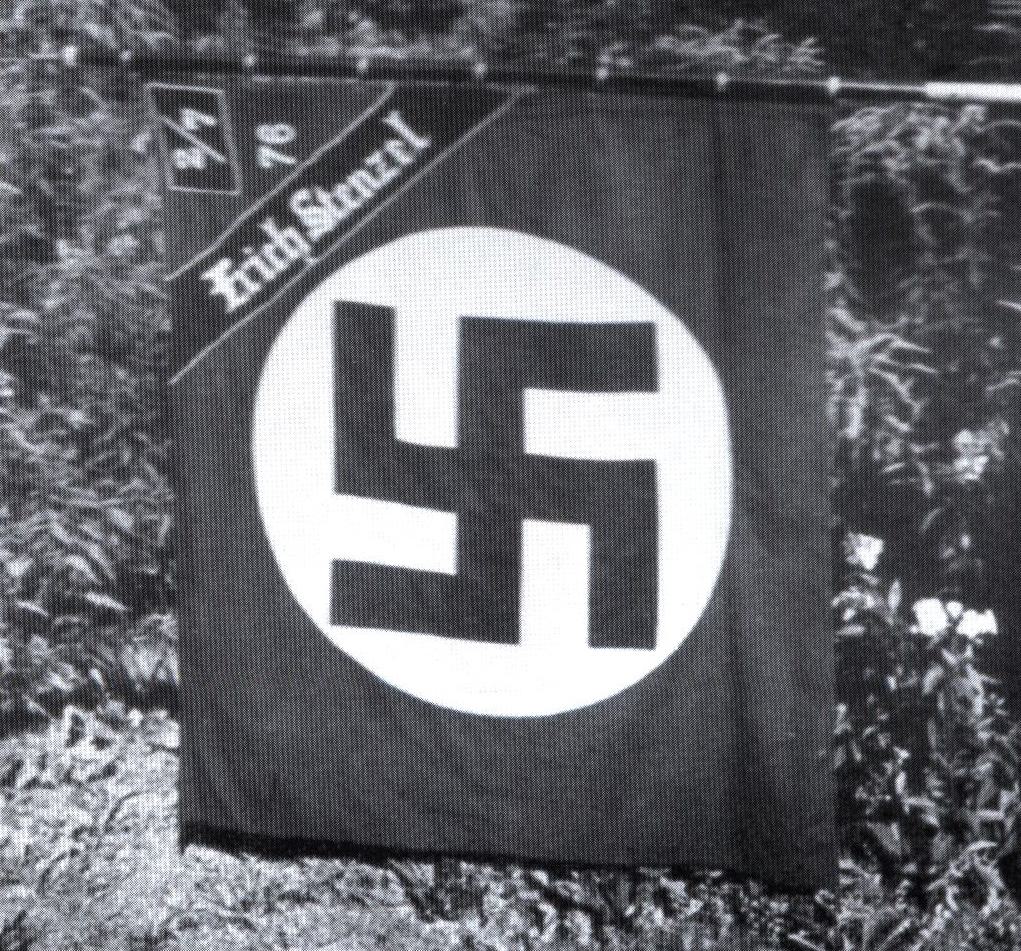
The flag of the SA storm „Erich Stenzel“. The flag bears both the old and the new storm number.
Erich Stenzel falls to the ground unconscious. The Scharführer is immediately taken to the St. Gertrauden hospital. The wounds appear to be only moderately severe and not threatening. A few days after waking up, he is to be discharged home. But suddenly his condition worsens. Only now do the doctors diagnose meningitis and a fractured skull. Erich Stenzel loses consciousness again. Without waking up from the coma, the young SA-Unterführer dies at around 12.30 p.m. on 13 January 1933.
Two weeks after the funeral, Sturm 76 marched through the Brandenburg Gate at the head of the endless torchlight procession. The Sturmabteilung named Sturm 2/7 after the fallen man, whose gravestone bore the inscription: „He died for Germany’s freedom.“
Hans Bernsau
(* 22 October 1905, † 18 January 1933 in Iserlohn)
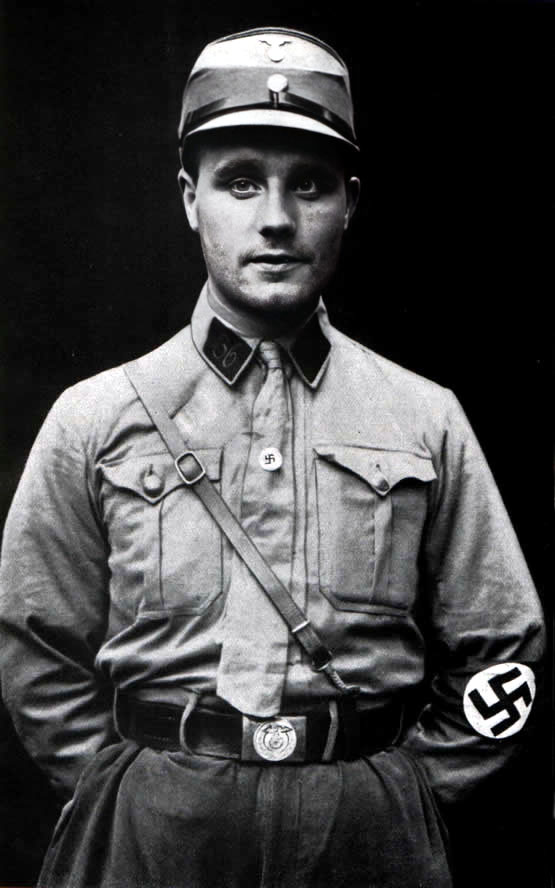
Hans Bernsau was a resistance fighter against the Weimar Republic and a Blood martyr to the National Socialist movement.
In 1926, Hans Bernsau joined the NSDAP and was a member of the Schleswig local group. Again and again he hurled the truth ruthlessly in the face of political opponents at meetings and rallies. The police threw him into prison more than once, trials were brought against him, meetings at which he was supposed to speak were banned - but nothing could stop him from fighting with youthful strength unwaveringly towards the great goal, the victory of the movement. From Schleswig he went to Iserlohn and stood his ground there as well. 12 days before the appointment to power, he was shot by communist bullets as he rushed to the aid of comrades in distress. The clerk died on 18 January 1933. A simple memorial plaque in Schleswig bears witness to Hans Bernsau’s death:
Fighting and struggling was his life,
National Socialism his only thought,
Free Germany his goal.
He became a shining beacon for us.

Monument for Hans Bernsau
Amalienplatz in Schleswig became Hans-Bernsau-Platz on 25 August 1934.
Fritz Wetekam
(* 10 November 1878, † 20 January 1933 in Düsseldorf)

Fritz Wetekam was a resistance fighter against the Weimar Republic and a Blood martyr of the National Socialist movement.
The oldest member of the Düsseldorf SA storm 13/39 was the squad leader Fritz Wetekam from Düsseldorf, a fifty-four-year-old factory blacksmith. He stood proudly at the head of the squad, to which his son also belonged. On 20 January 1933, the Sturm marched unitedly from a meeting back to the Sturmlokal. In Luisenstraße, four attackers rushed out of a communist pub and fired twenty pistol shots in succession at the peacefully marching SA men. Troop leader Fritz Wetekam was fatally injured by a shot in the lungs. He left behind his wife and two children.
Walter Spangenberg
(25 February 1933 in Cologne)

Walter Spangenberg was a resistance fighter against the Weimar Republic and a Blood martyr to the National Socialist movement.
On 24 February 1933, communists and National Socialists had clashed in Cologne on the fringes of NSDAP rallies. After one of these popular meetings, the perpetrators, all members of the Red Front Fighters’ League of Cologne North, treacherously shot the two locksmiths and SA men Walter Spangenberg and Winand Winterberg on their way home. The funeral of the two Blood martyres was also attended by police chief Walter Lingens and district president Hans Elfgen. The Cologne police arrested a number of communists after the crime. The public prosecutor’s office eventually brought charges against 17 communists. The murderers were said to have acted on the express written orders of the Cologne KPD. On 24 July 1933, six defendants were sentenced to death.
The West German Observer wrote:
„The red murderers who cowardly shot down our comrades from ambush will have to atone for their heinous crime with death. The iron will of order of the National Socialist movement lies heavy and powerful over our people.
In Cologne, Hansaplatz was renamed Spangenberg-Platz.
After the occupation of Germany, the memorial erected in Cologne’s Melaten cemetery and the double grave of the SA men were destroyed by occupying troops.
In 1998, the ‘Freie Kameradschaft Walter Spangenberg Köln’ was founded by Siegfried Lutz in memory of Walter Spangenberg’s sacrificial death.
Rudolf Brügmann
(*7.5.1909 - † 1.2.1933)
Distirct Mecklenburg-Lübeck, SA Group Nordmark
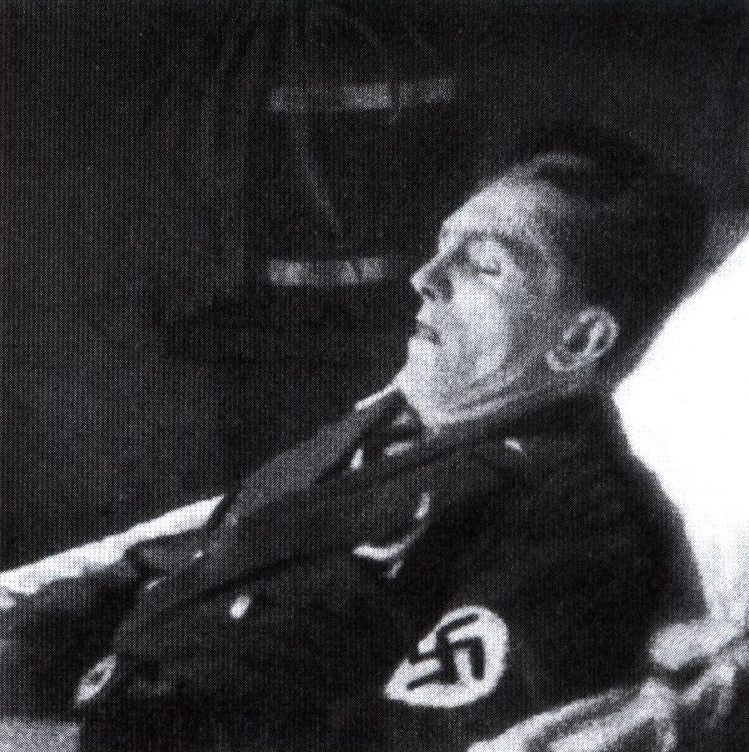
As in Berlin, in the days following Hider’s appointment as Reich Chancellor, there were ceremonial processions of the NSDAP and its branches throughout the Reich. This was also the case in northern Germany.
On the evening of 31 January 1933, a torchlight procession of the SA marched through the streets of the old Hanseatic city of Lübeck. The political opponents had recovered from the rigidity of the previous two days and took action against the procession.
Stones and bottles flew into the rows and marching blocks of the brown columns. Already in the hours before, the North German Reichstag representative of the SPD, Dr. Julius Leber, is said to have spoken to his comrades and called for violent resistance. The parliamentarian and editor-in-chief of the left-wing „Lübecker Volksbote“ was accompanied by his bodyguard, the Reichsbanner member Willi Rath. In the course of the evening there were serious clashes between the Reichsbanner and communists on the one hand and the police on the other.
The morning was already dawning over the brick houses when an SA squad met Leber and his bodyguard in Burgstraße. That the two men were travelling alone can almost be ruled out in a situation where the SA marches through the streets en masse. However, there are no further indications of the number of men in the groups. During the ensuing brawl, Dr. Leber is seriously injured in the head. Marine SA-Scharführer Rudolf Brügmann also fell to the ground, stabbed in the spleen. Moments before, the Reichstag deputy allegedly ordered his bodyguard to cut down the twenty-three-year-old sailor with the words „Stab him! The Marine SA man sits crumpled on the kerb before toppling over to one side and dying the same night.
Rudolf Brügmann was born in Berlin as the son of the merchant Karl Brügmann. His father died in 1918 as a result of a war injury.
Notwithstanding the parliamentary immunity, Dr. Leber was arrested together with his bodyguard, which led to a demonstration by the still existing Iron Front on 14 and 19 February 1933.
A little later, a court sentences Dr Julius Leber to f 8 months in prison as an instigator. His bodyguard Rath receives a prison sentence of one year. The comparatively lenient punishment may be due to the fact that an act of self-defence could actually be proven.
After Dr. Leber had served his sentence, he remained in the Esterwege and Sachsenhausen concentration camps until 1937. After his release, Leber was again active in the resistance, which is why he was arrested in 1944 and executed in Plötzensee in 1945.
Otto Blöcker
(26 February 1933 in Hamburg)
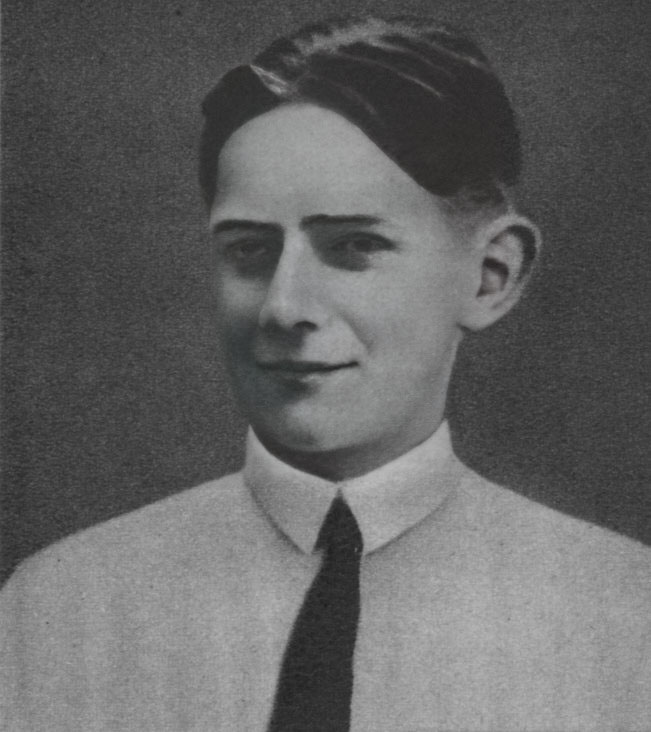
Otto Blöcker was a resistance fighter against the Weimar Republic and a Blood martyr to the National Socialist movement.
The schoolboy and Hitler Youth Otto Blöcker was shot dead by communists at the age of seventeen during a brawl with communists in the Eppendorf pub „Falkenburg“ near the Falkenried Terraces in Hamburg-Hoheluft.
There were three communists, among them Fritz (Fiete) Schulze, 38, a locksmith, political leader of the Red Front Fighters’ League and - ten years earlier - one of the main ringleaders of the so-called Red October Uprising in Hamburg. The other perpetrators Retslag, Fischer and others were also later convicted. Otto Blöcker’s school gathered in Hamburg-Ohlsdorf for his funeral.
A newspaper report of 20 January 1934 wrote about the sentences against the communist murderers:
Atonement for the murder of a Hitler boy.
Three death sentences in Hamburg.
On 26 February 1933, during a communist fire attack on a pub in the Hoheluft district of Hamburg, the Hitler youth Blöcker was murdered and another Hitler youth seriously injured. The communist murderers were sentenced in the presence of a large public and the Reich Governor.
The main defendant Fischer, who according to his own confession fired the fatal shots, was sentenced to death for joint murder, joint attempted murder and attempted manslaughter and to a total sentence of 15 years in prison. Furthermore, the defendants Dettmar and Helbig were sentenced to death for jointly committed murder and to a prison term of eight years each.
Three defendants were acquitted. All but two of the other defendants received prison sentences of 12 to 4 years. The defendant Schmuck received three years in prison, as he was still a juvenile in the criminal law sense at the time of the offence. The defendant Potent was sentenced to one year in prison for an offence against § 5 of the Ordinance of 19 December 1932.
The name Otto Blöcker was added to the list of the Immortal Followers of the Hitler Youth.
The Hamburg HJ home was given the name „Otto-Blöcker-Heim“. The street „Falkenried“ bore the name Otto-Blöcker-Straße until 1945. A district in Hamburg’s Hoheluft district was named „Otto Blöcker“. In Malente in Schleswig-Holstein, the area leader school of the Hitler Youth bore his name. In Hamburg, an Alster ship was named after him. After the occupation of Germany in 1945, the ship was renamed „Isebek“.
Christian Größmann [Crößmann]
(in Pfungstadt, 26 February 1933 in Lindenfels)
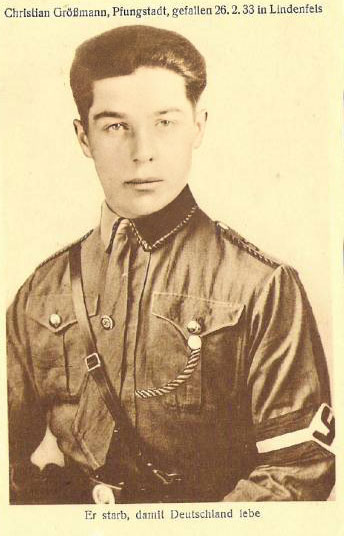
Christian Größmann [Crößmann] was a resistance fighter against the Weimar Republic and a Blood martyr to the National Socialist movement. The painter Christian Größmann died at the age of eighteen.
The Völkischer Beobachter reported on 28 February 1933:
“A National Socialist rally took place in Lindenfels am Odenwald on Sunday which, according to police reports, took place in complete peace and order. - Later, after the event, the Reichsbanner and the communists together carried out hunts for individual National Socialists, during which the 18-year-old Hitler Youth Christian Größmann from Pfungstadt was murdered by stabbing. The 18-year-old Hitler Youth Bohner from Darmstadt was injured by lung stabs. (...) As reported by the Gauleitung Hessen, the united red murder bandits from the SPD and KPD had equipped themselves with hatchets, knives and axes for the Lindenfels attack. The degenerate fellows even beat and kicked the corpse of the murdered Hitler boy.“
The name Christian Größmann was added to the list of the Immortal Followers of the Hitler Youth.
Josef Kristandl
(† 3 March 1933 in Graz)

Josef Kristandl was a Blood martyr of the National Socialist movement.
The SA man Josef Kristandl was fatally injured by Young Socialists in Graz on 3 March 1933.
Peter Frieß
(17 March 1933 in Lindenfels/Odenwald))
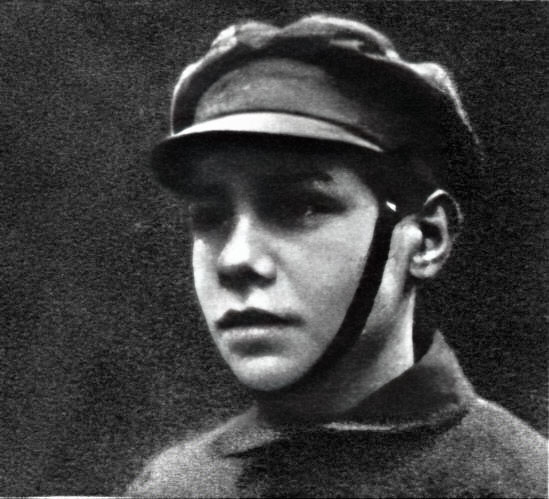
Peter Frieß was a resistance fighter against the Weimar Republic and a Blood martyr to the National Socialist movement. He died at the age of sixteen, the youngest of six siblings.
Peter Frieß was buried in Darmstadt’s Waldfriedhof cemetery on 21 March 1933. He was the second victim of the attack perpetrated on National Socialists by members of the Iron Front in Lindenfels.
In Querumer Forst near Braunschweig, two U-shaped buildings, designed by the Braunschweig senior civil engineer Hans Bernhard Reichow, housed the Hitler Youth area leader school „Peter Frieß“. The Darmstadt bann of the Hitler Youth also bore his honorary name.
His name was added to the list of the Immortal Allegiance of the Hitler Youth.
Matthias [Mathias] Schwarz
(† 11 June 1933 in Miesenbach)

Matthias [Mathias] Schwarz was a resistance fighter against the Weimar Republic and a Blood martyr of the National Socialist movement. The SA man was murderously stabbed to death by political opponents.